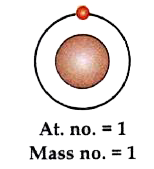Draw diagrams representing the atomic structures of the following:
Sodium atom
To draw the atomic structure of a sodium atom, follow these steps:
Step 1: Identify the Atomic Number and Mass Number
- Sodium has an atomic number of 11, which means it has 11 protons.
- The mass number of sodium is 23, which indicates that it has a total of 23 nucleons (protons + neutrons). Therefore, the number of neutrons is 23 - 11 = 12.
Step 2: Draw the Nucleus
- Start by drawing a small circle to represent the nucleus of the sodium atom.
- Inside the nucleus, write "11 protons" and "12 neutrons" to indicate the particles present.
Step 3: Draw Electron Shells
- Draw three concentric circles around the nucleus to represent the electron shells (K, L, and M shells).
- Label the innermost circle as the K shell, the middle circle as the L shell, and the outermost circle as the M shell.
Step 4: Fill the Electron Shells
- The K shell can hold a maximum of 2 electrons. Draw 2 dots in the K shell to represent the 2 electrons.
- The L shell can hold a maximum of 8 electrons. Draw 8 dots in the L shell to represent the 8 electrons.
- The M shell can hold a maximum of 18 electrons, but since sodium has only 1 electron left, draw 1 dot in the M shell to represent the 1 electron.
Step 5: Finalize the Diagram
- Ensure that the nucleus is clearly labeled and that the electron shells are properly filled with the correct number of electrons.
- Your final diagram should show a nucleus with 11 protons and 12 neutrons, surrounded by three electron shells with the correct number of electrons in each shell.
Diagram Representation:
Mshell(1e≤ctron)∙Lshell(8e≤ctrons)∙∙∙∙∙∙∙∙Kshell(2e≤ctrons)∙∙(Nuc≤us)(11pro→ns,12≠utrons)
- Sodium has an atomic number of 11, which means it has 11 protons.
- The mass number of sodium is 23, which indicates that it has a total of 23 nucleons (protons + neutrons). Therefore, the number of neutrons is 23 - 11 = 12.
- Start by drawing a small circle to represent the nucleus of the sodium atom.
- Inside the nucleus, write "11 protons" and "12 neutrons" to indicate the particles present.
- Draw three concentric circles around the nucleus to represent the electron shells (K, L, and M shells).
- Label the innermost circle as the K shell, the middle circle as the L shell, and the outermost circle as the M shell.
- The K shell can hold a maximum of 2 electrons. Draw 2 dots in the K shell to represent the 2 electrons.
- The L shell can hold a maximum of 8 electrons. Draw 8 dots in the L shell to represent the 8 electrons.
- The M shell can hold a maximum of 18 electrons, but since sodium has only 1 electron left, draw 1 dot in the M shell to represent the 1 electron.
- Ensure that the nucleus is clearly labeled and that the electron shells are properly filled with the correct number of electrons.
- Your final diagram should show a nucleus with 11 protons and 12 neutrons, surrounded by three electron shells with the correct number of electrons in each shell.
Mshell(1e≤ctron)∙Lshell(8e≤ctrons)∙∙∙∙∙∙∙∙Kshell(2e≤ctrons)∙∙(Nuc≤us)(11pro→ns,12≠utrons)
Topper's Solved these Questions
- ATOMIC STRUCTURE AND CHEMICAL BONDINGBOOK - ICSECHAPTER - ATOMIC STRUCTURE AND CHEMICAL BONDINGEXERCISE - EXERCISE 4(D)
21 Videos
- ATOMIC STRUCTURE AND CHEMICAL BONDINGBOOK - ICSECHAPTER - ATOMIC STRUCTURE AND CHEMICAL BONDINGEXERCISE - EXERCISE 4(B)
12 Videos
- ATMOSPHERIC POLLUTIONBOOK - ICSECHAPTER - ATMOSPHERIC POLLUTIONEXERCISE - EXERCISE 8(D)
38 Videos
- CHEMICAL CHANGES AND REACTIONSBOOK - ICSECHAPTER - CHEMICAL CHANGES AND REACTIONSEXERCISE - EXERCISE 2(C)
30 Videos
Similar Questions
Draw diagrams representing the atomic structures of the following:
Carbon atom
View SolutionDraw diagrams representing the atomic structures of the following:
Oxide ion.
View SolutionDraw diagrams representing the atomic structures of the following:
Chloride ion
View SolutionStructure of Atom
View SolutionStructure of Atom
View SolutionDraw a diagram of the internal structure of the human ovary.
View SolutionDraw orbital diagrams for the formation of the following compounds.
Sodium chloride
View SolutionExplain with the help of (i) an ionic equation (ii) electron dot structural diagram (iii) atomic or orbital structural diagram for the formation of the following:
(a) Sodium chloride (b) Calcium oxide (c) Magnesium chloride.
View SolutionDraw a labelled diagram of the structure of the eye.
View SolutionThe diagram represents an isotope of hydrogen (H). Answer the following:
Do isotopes have the same atomic number or the same mass number.

View Solution
